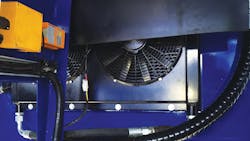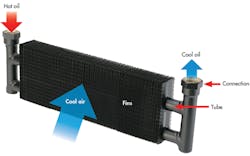This file type includes high-resolution graphics and schematics when applicable.
Sizing and selecting a heat exchanger to cool a mobile hydraulic system presents some real challenges. First, you have to come up with an accurate assessment of how much heat the system will generate. Then you have to account for varying load conditions, ambient temperatures, and changes that may occur over time.
Sometimes it can seem like shooting darts and hoping that your decision will score a bull’s-eye. Should you double the oil cooler’s size to keep the hydraulic system extra cool? Would a better choice be to use a smaller heat exchanger made of premium materials that can increase the heat dispersion? Where is equilibrium between size and efficiency?
Even after carefully calculating a system’s heat load and coming up with figures you are confident with, unforeseen factors may creep in during development. For instance, engine compartments might be smaller than anticipated and fresh-air flow could be restricted. Engine manufacturers provide specifications for heat removal, and most heat exchanger companies will adjust to make sure they have a large enough cushion above these specifications. The same should be done with hydraulics.
Importance of Removing Heat
A good general rule for a mobile hydraulic system is that one-third of the input power will need to be removed as heat. For example, a hydraulic system driven by a 75 hp engine will produce about 25 hp of heat, which needs to be removed. Many industrial hydraulic systems can dissipate heat through their reservoir. A large reservoir provides large surface areas to transfer heat from the hydraulic fluid to the external surroundings. However, reservoirs in mobile hydraulic systems generally are made as small as practical and often located where little opportunity for heat transfer exists.
Without adequate cooling for the hydraulic system, the hydraulic oil will overheat, causing it to quickly degrade. Providing a high-temperature shutoff switch can help protect the system from extreme overheating. However, shutting down the hydraulic system renders the equipment unusable until ambient air cools the fluid back down to below the switch’s shutoff temperature. Not only is this downtime unacceptable in most cases, but the system will probably operate at fluid elevated temperatures most of the time. Again, this will cause problems quickly degrading the hydraulic fluid.
Heat-Exchanger Options
The solution, then, is to incorporate a heat exchanger into the hydraulic system. A heat exchanger routes the hydraulic oil through narrow passages with large surface areas that transfer heat from the hydraulic oil to a fluid (usually air or water) that carries heat away. So the first question in selecting a heat exchanger is whether to use water cooling or air.
Industrial hydraulic systems often use water-cooled heat exchangers. Water is very effective at transferring heat, but it is rarely a realistic option for mobile equipment. That’s because engine coolant usually runs at temperatures of 180° F or higher, which exceeds the maximum temperature recommended for most hydraulic fluids. Even if the fluid could tolerate high temperatures for extended periods, the temperature differential between the hydraulic fluid and the water would be insufficient to provide significant cooling. So scratch off water.
That leaves us with air-to-oil heat exchangers. You can’t rely on ambient air alone to provide enough heat transfer to cool the hydraulic oil in a heat exchanger. Instead, a fan is needed to force ambient air through the heat exchanger. However, air temperature can vary dramatically with mobile equipment. A single machine may operate in below-freezing temperatures much of the time, and in temperatures exceeding 100° F at other times. Loads can also vary widely because equipment may require little cooling while running in standby mode for long periods. However, that same machine may require maximum cooling while operating at full load.
This means an air-to-oil heat exchanger should be selected to provide maximum air flow for the severest operating conditions, but operate more efficiently by providing less air flow when the hydraulic system requires less cooling. The traditional method to move air through a heat exchanger was to use an engine-driven fan. However, motor-driven fans have proven to provide more effective and more energy-efficient cooling than a fan running at engine speed. The fan operates at full speed when maximum cooling is needed, and they run at slower speeds—or not at all—when less cooling is called for. They can even rotate in reserve to help clean the heat exchanger by blowing debris out.
Heat exchangers have a coolant fluid sweet spot. If you choose a huge cooler and put only minimal fluid through it, the system will not operate efficiently. Plus, you have spent more money when a smaller, less-expensive cooler would have been more effective. On the other hand, if you try to push too much fluid through a smaller cooler, you reach a point at which the system is saturated and cannot remove any more heat. This would increase pressure drop and create even more heat to only make the problem worse.
Hydraulic or Electric?
You can use hydraulic oil to power a hydraulic motor and rotate a fan. If hydraulic flow is readily available, or the system allows enough extra power to produce this flow without hindering the machine’s operation, this can be a great option. The efficiency of the hydraulic motor should be considered against other options—an electric motor for instance. The advantage of hydraulics is that the flow and pressure needed to develop the necessary power (fan speed) in these cooling systems is already available on the machine.
The other choice is to use an electric motor to spin a fan. These systems are usually on smaller mobile systems, but larger machines may use multiple electric fans, which can run at different speeds or not at all, depending on cooling demand. A consideration with electric fan drives is that the machine’s electrical system must have the capacity to drive the electric motor or motors. The controls available for the electric fan are inexpensive, and the fan speed can be easily altered. This can be an easy-to-install system can run very efficiently.
Other Considerations
Now we need to know how we are going to get the oil or fluid into and out of the cooler. There are also correction factors for the type and viscosity of hydraulic fluid being used. Additional questions must also be factored into the final solution.
Does the system have enough flow to reliably pump the fluid through the cooler, allowing the heat transfer to take place? If not, can you incorporate an additional pump solely to circulate oil through the cooler. This setup is often referred to as a kidney loop and presents an opportunity to provide additional filtration for the hydraulic system.
Can pressure spikes or flow surges be transmitted to the oil lines going to or from the oil cooler? If so, you must determine what the maximum intermittent pressure will be. If not accounted for, pressure surges even of very short duration can create leaks in the heat exchanger. Solutions would be to take measure to dampen spikes or specify a heat exchanger that can accommodate the peak pressures.
Ensure that the heat exchanger can handle up to the worst conditions anticipated. Can the heat exchanger provide enough cooling with the system operating at its highest temperature in the highest ambient temperatures?
A Short Scenario
Let’s go back to the hypothetical example above, where we estimated that we need to remove 25 hp of heat from our hydraulic system. Following is a common situation I have encountered in my 15 years of working with hydraulic applications.
Say your system uses Chevron AW46 hydraulic fluid. Assume maximum return flow from several hydraulic motors varies from 30 to 40 gpm with no pressure spikes. Further assume the machine will be running in ambient temperatures that vary from 40° F in the winter to 95° F in the summer.
Do you want the fan to run continuously or only after the system reaches a certain temperature? A continuously running fan can spin at variable speed to match cooling capacity to the heat load. This is the best solution for a hydraulic system because it keeps the temperature of the hydraulic fluid relatively stable.
Most mobile equipment operates in dirty environments, with a high potential of airborne dust and dirt. Therefore, you probably want the fan to push air through the cooler rather than pull air into the cooler. The machine has a dc electrical system, but you don’t want to place the additional load of a fan motor on the battery, so you opt for a hydraulic motor driven fan system. You have a fair amount of space to mount a cooler but want some options before deciding on a mounting envelope.
This is a lot of variables. If you want peace of mind, now is the time to call in a heat exchanger professional. He or she could be a Certified Hydraulic or Fluid Power Specialist or technical rep from a heat exchanger manufacturer. Either way, they can take the information you provide and offer suggestions on the material makeup (copper shell and tube or aluminum extrusion), size and shape, larger overall package or smaller package with higher fan speed, plus any other systemic factors to optimize your system.
Paul Badowski is Account Manager, Mobile Hydraulics & Control Systems Group at Cross Co. For more information, call (336) 856-6000, or visit crossfluidpower.com.
Looking for parts? Go to SourceESB.
About the Author

Leaders relevant to this article:



